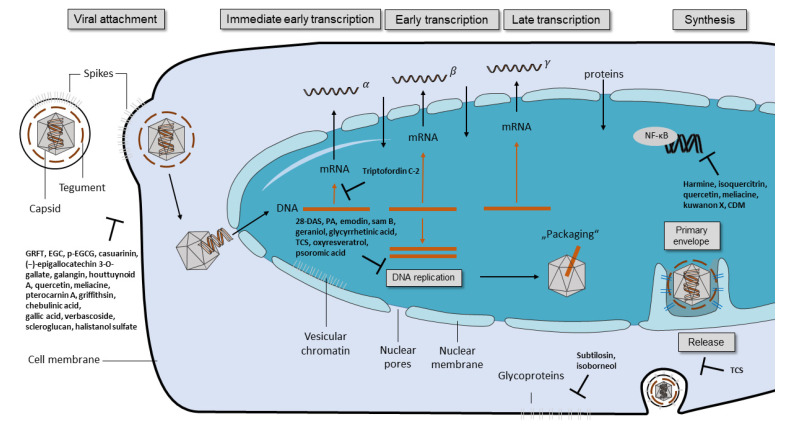Figure 3.
Replication cycle of herpes simplex viruses, including the targets of different natural antiviral compounds. During viral attachment, the viral glycoproteins B, D, and heterodimers of gH/gL bind to the host cell receptors. The transcription phase is divided into immediate-early, early, and late transcription where HSV genes are transcribed as α-, ß-, and γ-genes, respectively. These mRNAs are translated into immediate-early, early, and late proteins. Following DNA replication and the synthesis of the viral capsid, the primary envelopment of the capsid takes place. Subsequently, the capsids are released from the nucleus. Then, virions are released after secondary envelopment. Antiviral compounds may directly interfere with the distinct steps of the viral replication cycle or influence the cellular factors that are important for viral replication. Substances disturbing the viral replication cycle are 28-DAS, PA, emodin, sam B, geraniol, glycyrrhetinic acid, TCS, oxyresveratrol, and psoromic acid. Compounds such as harmine, isoquercitrin, quercetin, meliacine, kuwanon X, and CDM exhibit antiviral effects by addressing the primary essential cellular processes. The transcription factor NF-κB is activated by HSV-1 and HSV-2, which favors the infection. GRFT = griffithsin, EGC = epigallocatechin, p-EGCG = palmitoyl-EGCG, 28-DAS = 28-deacetylsendanin, PA = psoromic acid, TCS = trichosanthin, CDM = 1-cinnamoyl-3,11-dihydroxymeliacarpin.

